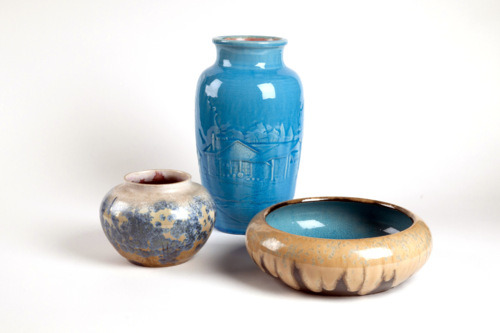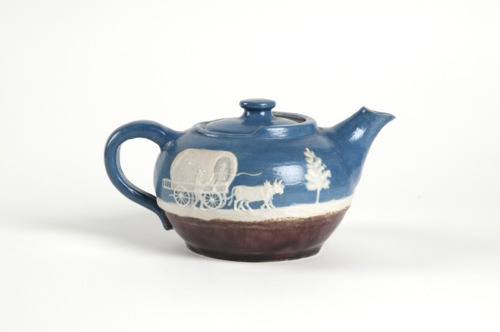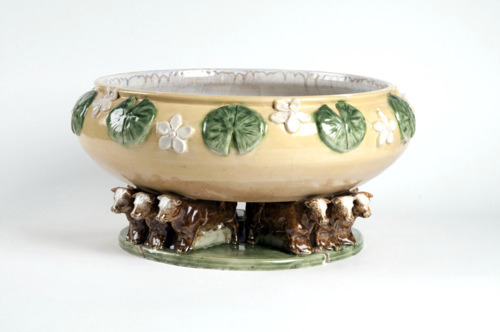You have been working at the University of South Carolina’s McKissick Museum for over ten years. What are the main responsibilities and attributes of being the Chief Curator of Collections & Research?
As Chief Curator of Collections and Research, my responsibilities include overseeing the research and care for the permanent collections. The permanent collections include natural science collections (rocks, minerals, fossils, meteorites and shells) and material culture collections which include fine art, furniture, textiles (clothing, quilts, other domestic textiles, baskets, shoes, accessories), ceramics, glass, metal objects, political materials, silver and objects relating to the history of the University of South Carolina. I guide and implement the collecting activities of the museum in terms of new acquisitions and research, identify long-term care needs of the collections in terms of conservation and storage, and work with my colleagues on various exhibition projects. My research focus is on Southern pottery but I’m knowledgeable about traditional basket traditions of the South, South Carolina history and politics, and University history. In a mid-size institution like McKissick Museum, and particularly at a University, it is important to constantly learn about the various types of museum collections.

During the 26th of May and the 27th of July, USC’s McKissick Museum will host a very important exhibition of rare 20th century ceramics made by Walter B. Stephen. Tell us about the heritage of Walter’s work.
Walter Stephen was born in Nebraska in 1876. His family moved to 100 acres of land in Shelby County, Tennessee in 1897. It was on this property where he discovered layers of pink, white and yellow clay. His intellectual and creative curiosity was fostered by his mother. Nellie Stephen was an amateur artist who taught blackboard art and painting. Walter did not begin working with clay until he was twenty-seven years old (1903). Together, Walter and his mother began experimenting with the clay and the decorating process. It is also possible that the two had seen George Ohr, “the Mad Potter of Biloxi,” demonstrating his pottery skills at the Louisiana Purchase Exposition in 1904. Originally named, “Stephen and Son,” they renamed their pottery “Nonconnah” after the local creek. The forms were typical decorative vases and pitchers of the period. The decoration was different as Mrs. Stephen’s painted layers of porcelain slip onto the wares, often adding colored oxides for leaves and branches. This paste on paste, or cameo, technique was similar to the original method employed by Josiah Wedgwood for his Jasperwares. In 1910, Walter’s parents died and he continued to operate the Nonconnah pottery in Tennessee until 1912. A year later, he moved to the Skyland community of North Carolina, south of Asheville, and established the Nonconnah Pottery in partnership with Mr. and Mrs. Clarence Pine Ryman. At this iteration of the Nonconnah Pottery, Stephen continued to work at the potter’s wheel, creating matte glazed cameo wares until 1916. The Ryman’s operated the Nonconnah until 1918, producing molded and slab constructed wares with simple blue and brown glazes.
It would be almost a decade after Stephen’s departure from Nonconnah before he established the Pisgah Forest Pottery. During this period, he became closely associated with Oscar L. Bachelder of the Omar Khayyam Pottery. Walter worked for a short time with Bachelder but did not want to make utilitarian pottery. It was also during the early 1920s, that he was experimenting with local clay,glazes and firing techniques. Fragments from his Arden home indicate his interest in the Chinese celadon and red glazes.
The Pisgah Forest Pottery, which officially opened in 1926, had a good sized pottery shop where one room was a work area with his wheel, and a second which was the sales and kiln room. A large updraft, bottle kiln was built a few feet south of the shop. As the years progressed, Stephen expanded the pottery and hired additional men to help with clay preparation and the firing. The forms and glazes show the heavy influence of Chinese ceramics, particularly the Han and Ming dynasties. Glossy greens and copper red glazes were produced as well as beautiful “Persian turquoise” and “Aubergine Wine.” These colors were exceptionally vibrant over the white porcelaneous body. The crystalline glaze was another area of interest for Stephen. His undertakings were aided by his step-son Herman Case. According to Grady Ledbetter, who began working at Pisgah Forest in 1929, Herman Case helped Walter develop the finest crystalline glazes from 1931 until his death in 1936. Rodney Leftwich states, “Case experimented by adding various oxides, such as copper, iron, cobalt, manganese and uranium to the formulas, and thereby developed a wide variety of crystal colors, which included white, yellow, blue, green, brown, gold, silver, and violet.” The results were exceptional.
Many others worked with Stephen over the years. In the early 20th century china painting tradition, women such as local artist Nancy Jones, who would take the green ware from Pisgah Forest and decorate it. She and her students would carve the unfired pottery or apply underglaze decoration. The decorative motifs, similar to those of Nellie Stephen, included rhododenrons, roses, dogwoods, irises and local landscapes. Grady Ledbetter became a potter in his own right. Thomas Case, Stephen’s step grandson, joined the pottery in 1948. These two men worked with Stephen until his death in 1961. They operated the pottery as a partnership until Ledbetter’s death in 1998. Case operates the pottery on a very limited basis today and is assisted by his wife Dorothy.
This is a very brief overview of Stephen’s work. A more definitive explanation can be found in Rodney Leftwich’s book, “Pisgah Forest and Nonconnah: The Potteries of Walter B. Stephen” which was published in 2006. It details the different glazes, production marks, values of the pottery, and Stephen’s marketing strategies. Black and white historic photographs of Stephen working in his shop are accompanied by beautiful studio photographs of the pottery.

Walter B. Stephen, Pisgah Forest stoneware teapot with slip decoration and gloss and crackle glazes, 1947. Courtesy McKissick Museum, University of South Carolina.
The exhibition, titled “Pisgah Forest and Nonconnah: The Potteries of Walter B. Stephen”, presents 76 works, from the first pots that he fired near Nonconnah Creek in Tennessee to crystalline vessels produced at Pisgah Forest near Asheville. Do you find yourself connected to a particular stage of Walter’s outstanding career?
I became familiar with Pisgah Forest Pottery after learning about Asian porcelains and English ceramics while working with Nancy Lester, who was the Decorative Arts Curator for the Phillip Trammel Shutze collection at the Atlanta History Center. The cameo works are the pieces that I was first drawn to many years ago due to similarity of technique to Wedgwood’s Jasperware. Stephen’s regional scenes made it very American. Aesthetically, I appreciate the gracefulness of the Asian forms with the glossy and crackle glazes. The combination of the turquoise blue with the wine is a favorite. It is exciting to make connections between Asian ceramics and the Arts and Crafts traditions found in the South. Potters are always looking at the work of other potters; some share ideas and collaborate. Many potters are able to travel to other countries to share and create; others like Stephen travelled through books and visits to museums and expositions. He was constantly learning, working and exploring.
Where was the exhibition first exhibited at and what was the public’s reaction to the pieces? How do you think the McKissick Museum’s public will respond to the exhibition?
The exhibition was organized by Stanton Thomas, Curator of European and Decorative Art at the Memphis Brooks Museum of Art in Memphis, Tennessee. According to Stanton, “I’m fascinated that we have an exhibition by a largely undiscovered and incredibly innovative art potter who began working in Shelby County around 1900. Stephen is a little idiosyncratic and very much an individualist, and at the same time, he’s part of the larger Arts and Crafts movement, when artists were getting away from mechanization and focusing on the handmade.”
McKissick Museum’s audience will be excited to see these beautiful works. I think many of our visitors know about North Carolina’s pottery traditions as they relate to folk art, but might not be aware of the wide ranging ceramics being made outside of Asheville during most of the 20th century. Many generations of South Carolinians have travelled to the North Carolina Mountains; I think this exhibition will have them think back onto those experiences. Do they have one of these beautiful pieces of “America’s Finest Pottery” at home? Did their grandmother buy a piece during a summer or fall trip to the mountains? We hope that the visitor will appreciate Stephen’s creativity and his place as an important American potter/ceramic artist.
What events are planned in connection with the exhibition?
On Thursday, June 21st we will have an exhibition reception along with a gallery talk and book signing with Rodney Leftwich, ceramicist and author of “Pisgah Forest and Nonconnah.” The time is 5:30 – 7:30 at McKissick Museum.
On Friday, June 22nd, McKissick Museum will present an all-day ceramic symposium, “The Art of Collecting Southern Pottery: Curiosity and Inspiration.” The program begins at 10:00 a.m. and concludes at 4:00 p.m. I will moderate the symposium and our presenters include Rodney Leftwich, Karen Swager of Brunk Auctions, Frank Neef, crystalline potter, Winton and Rosa Eugene of Pottery by Eugene, and Barbara S. Perry, Ph.D., noted author on American Ceramics. Dr. Perry’s keynote is titled, “Beyond the Pale: Southern Pottery in Context.” Rodney will speak about his experiences collecting Pisgah Forest pottery and his interactions with Grady Ledbetter and Thomas Case, who continues to operate Pisgah Forest Pottery on a limited basis. Karen Swager will speak to the ins and outs of working at an Auction House that specializes in North Carolina ceramics. The mid-day keynote by Dr. Barbara S. Perry will provide the art historical context for Nonconnah and Pisgah Forest Pottery along with the work of other Southern potters, past and present. Potters Winton and Rosa Eugene and Frank Neef will discuss and demonstrate the techniques associated with their works. Neef will focus on the crystalline glaze and its origins in the United States. The symposium will end with closing remarks about the presentations and how the ceramic symposium functions within McKissick Museum’s collections and exhibition goals.

Walter B. Stephen, Pisgah Forest stoneware bowl with molded elements, 1950. Courtesy McKissick Museum, University of South Carolina.
What will be the biggest challenges of organizing the exhibition? Tell us about the organizational process; how many people are and how many will be involved in the making of?
The biggest challenge in organizing the exhibition at McKissick Museum was where to store the pottery while our galleries and storage areas are undergoing environmental upgrades. The pottery will arrive from off-site storage in mid-May and it will take a few hours to bring the boxes inside. Later, a team of four people (myself, the Curator of Exhibitions and Collections Management, the Curator of Exhibitions and a Graduate Assistant) will unpack and check the condition of the pottery and then install the pieces in the gallery. The Curator of Exhibitions will print out the labels and light the cases once everything is in place. Three to four staff members have been involved with the programming, public relations and marketing efforts. Postcards and advertisements have been created to promote the exhibition, the opening and the symposium.
Do you think that the modern society is doing enough to research and preserve its artistic heritage, like Walter B. Stephen’s work? You have published a number of remarkable publications that enrich and give value to the pottery of the 19th and 20th century.
There are so many topics and ideas that bombard our modern society – from the wars and conflicts to the lifestyles of the rich and famous. I do think that more could be done to support the collective arts and cultural heritage. Additionally, artists of all types along with museum and historic preservation professionals are doing more to advocate for their programs and research. The “creative class” does much to increase the quality of life for our communities. That said there are many artists whose work would benefit from additional research and examination. Stephen did much to promote his pottery when he was living. Tourists to the Asheville area bought Pisgah Forest Pottery and took it home with them, taking North Carolina pottery to all parts of the country. It is often a focused individual, or community/specialized group, who provide the initial spark and research that will then lead to an article, a book, and/or museum exhibition. In many museums, there are artists, objects, and subjects that would benefit from additional research of a master’s thesis or doctoral dissertation. With funding challenges and the shrinking of curatorial staff, museums are turning to alternate methods for having research conducted on the collections. “Crowdsourcing” is a recent buzz word for engaging and utilizing outside experts or even volunteers to research objects or even to conduct transcriptions of diaries and primary documents.

Walter B. Stephen, Pisgah Forest stoneware vase with two handles. Slip decoration on matte glaze with crackle, gloss, and crystalline glazes below, 1934. Courtesy McKissick Museum, University of South Carolina.
The University of South Carolina’s McKissick Museum is undergoing major upgrades and renovations. What are the future plans of the museum and what are its main goals for the next years?
The improvements to McKissick Museum include upgraded HVAC systems for our gallery spaces and new HVAC systems for our storage areas. The “horseshoe” of the University of South Carolina campus is a designated historic district, as it dates to 1801. The museum is situated at the top of the horseshoe. Because of this designation, the exterior windows are being refurbished. The original metal frames are being sand-blasted and repaired. New thermal glass will replace the old single panes. Together, these changes will improve the long-term, environmental conditions of our galleries and storage areas. They should also improve our energy efficiency. The galleries had to be closed for these upgrades to take place.
McKissick Museum will reopen with the exhibit “Pisgah Forest and Nonconnah” in the second floor North Gallery. Our annual fundraiser exhibition will open a few weeks later. In the fall, the exhibition, “The Ultimate Vacation:” is a result of several years of collaboration between Dr. Allison Marsh of the Public History department, research conducted by graduate students in Public History and the University’s Museum Management courses, under the direction of Dr. Lana Burgess. Another fall exhibit will focus on the dynamic relationship of Students and the Athletic Programs at the University of South Carolina. The title “Get Cocky” is a word play upon the University’s beloved mascot.
2013 will bring exhibitions drawn from graduate student research into the history of the Mitchellville community after the Civil War, along with another exhibition that looks into Sideshows and the related communities surrounding circuses and fairs. The year will also see the opening of a permanent folklife gallery which will allow the Museum to continually present objects from our strongest collections, those developed from original research and fieldwork about traditional arts of the South. Communities of potters to be featured include those working in Edgefield, South Carolina, the North Georgia mountains, part of Alabama and Kentucky, and the many areas of North Carolina including Buncombe County, the Catawba Valley and Seagrove. Some of the featured artists and subjects can be found on the website.
By Vasi Hirdo. The interview was published in Ceramics Now Magazine, Issue 2.




















